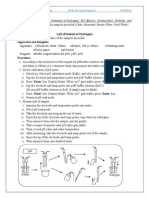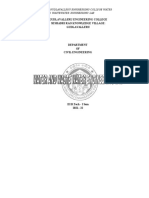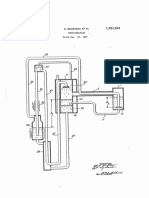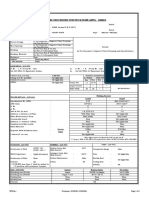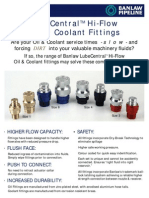BY - SAURABH BARMAN (AWS Practical Lab Manual)
BY - SAURABH BARMAN (AWS Practical Lab Manual)
Uploaded by
SauRabh BaRmanCopyright:
Available Formats
BY - SAURABH BARMAN (AWS Practical Lab Manual)
BY - SAURABH BARMAN (AWS Practical Lab Manual)
Uploaded by
SauRabh BaRmanOriginal Title
Copyright
Available Formats
Share this document
Did you find this document useful?
Is this content inappropriate?
Copyright:
Available Formats
BY - SAURABH BARMAN (AWS Practical Lab Manual)
BY - SAURABH BARMAN (AWS Practical Lab Manual)
Uploaded by
SauRabh BaRmanCopyright:
Available Formats
GOVIND BALLABH PANT INSTITUTE OF
ENGINEERING & TECHNOLOGY
(GBPIET), PAURI GARHWAL (U.K)
DEPARMENT OF CIVIL ENGINEERING
AWS & WWC ENGINEERING
LAB MANUAL
Approved By :- Prepared By :-
Dr. H.L Yadav Mr. Saurabh Barman
Assistant Professor (200090714005)
M.Tech IE (2020-2022)
AWS & WWC, DEPARTMENT OF CIVIL ENGINEERING GBPIET, UTTARAKHAND, INDIA 1
AWS & WWC ENGINEERING
‘Infrastructure Engineering’
LIST OF EXPERIMENTS
S.NO NAME OF EXPERIMENTS PAGE NO.
FROM TO
1. Determination of pH of Waste Water 03 04
2. Total solid, Dissolved solid and Suspended 05 08
solid
3. Determination of Sludge Volume Index (SVI) 09 11
4. Determination of B.O.D 12 14
5. Determination of C.O.D 15 16
AWS & WWC, DEPARTMENT OF CIVIL ENGINEERING GBPIET, UTTARAKHAND, INDIA 2
EXPERIMENT NO.1
DETERMINATION OF pH OF WASTE WATER
AIM : TO DETERMINE pH OF A GIVEN WATER SAMPLE
INTRODUCTION :
The term pH refers to measure of hydrogen ion concentration in a solution and defined as the
negative log of H+ ions concentration in water and wastewater. Values of pH, 0 to a little less
than 7 are termed as acidic and values of pH a little above 7 to 14 are termed as basic. When the
concentration of H+ and OH- ions are equal then it is termed as neutral pH.
APPARATUS USED : pH meter, Beaker.
REAGENT: Buffer solutions of known pH value
PROCEDURE :
Three major steps are involved in the experiment.
1. Preparation of Reagents
2. Calibrating the Instrument
3. Testing of Sample
STEPS :
1) Perform calibration of pH meter using standard pH solutions. The calibration procedure would
depend on pH range of interest.
2) In a clean dry 100 ml beaker take the water sample and place it in a magnetic stirrer, insert the
Teflon coated stirring bar and stir well.
3) Now place the electrode in the beaker containing water sample and check for the reading in pH
meter. Wait until you get a stable reading.
4) Take the electrode from the water sample, wash it with distilled water and then wipe gently with
soft tissue.
RESULT :
pH of given water sample is .
AWS & WWC, DEPARTMENT OF CIVIL ENGINEERING GBPIET, UTTARAKHAND, INDIA 3
ENVIRONMENTAL SIGNIFICANCE :
Determination of pH is one of the important objectives in biological treatment of the wastewater.
In anaerobic treatment, if the pH goes below 5 due to excess accumulation of acids, the process
is severely affected. Shifting of pH beyond 5 to 10 upsets the aerobic treatment of wastewater.
In these circumstances, the pH is generally adjusted by addition of suitable acid or alkali to
optimize the treatment of the wastewater. pH value or range is of immense importance for any
chemical reaction. A chemical shall be highly effective at a particular pH. Chemical coagulation,
disinfection, water softening and corrosion control are governed by pH adjustment. Lower value
of pH below 4 will produce sour taste and higher value above 8.5 a bitter taste. Higher values of
pH hasten the scale formation in water heating apparatus and also reduce the germicidal potential
of chlorine. High pH induces the formation of tri- halomethanes, which are causing cancer in
human beings.
AWS & WWC, DEPARTMENT OF CIVIL ENGINEERING GBPIET, UTTARAKHAND, INDIA 4
EXPERIMENT NO.2
DETERMINATION OF TOTAL SOLID, DISSOLVED SOLID &
SUSPENDED SOLID
AIM : TO DETERMINE TOTAL SOLIDS OF GIVEN SAMPLE.
PRINCIPLE :
Total solids are determined by evaporating a well mixed sample and dried to constant weight in
an oven at 103 to 1050C and weighing the dry residue left. The increase in final weight than the
initial weight of crucible indicates total solids.
APPARATUS USED : Crucible, Muffle furnace, measuring cylinder, weight balance, oven,
desiccators.
PROCEDURE :
1. Take the weight of empty crucible
2. Take 50 ml of given water sample in a crucible.
3. Evaporate the sample at 103 to 1050C for 24 hrs.
4. Again ignite the crucible for 15-20 minutes in a muffle furnace whose temperature is
maintained to 550+500C until the constant weight is attained. Cool it.
5. Note down the weight of crucible with residue.
OBSERVATION :
1. Weight of empty crucible (B): gm
2. Weight of empty crucible with residue (A): gm.
CALCULATION :
Total solids (TS) mg/l = {(A-B) x 1000 x 1000} / ml
of sample (V), where,
A: Final weight of the crucible with residue in gm
B: Initial weight of the empty
crucible in gm.
V: Volume of sample taken in ml.
AWS & WWC, DEPARTMENT OF CIVIL ENGINEERING GBPIET, UTTARAKHAND, INDIA 5
RESULT :
The amount of total solids determined from the given water sample is mg/l.
ENVIRONMENTAL SIGNIFICANCE :
Total solids determination is used to assess the suitability of potential supply of water for various
uses.
CONCLUSION :
The amount of total solids determined from the given water sample is mg/l.
DETERMINATION OF TOTAL SUSPENDED SOLID
AIM : TO DETERMINE TOTAL SUSPENDED SOLIDS FROM GIVEN
SAMPLE.
PRINCIPLE :
The residue which remains on filter paper after filtration. The dry weight of this residue is
termed as total suspended solids.
APPARATUS USED : Whatman filter paper no. 44, measuring cylinder, weight balance,
oven, desiccator, funnel, tripod stand.
PROCEDURE :
1. Take a tripod stand and put it on the table to which funnel is placed.
2. Take initial weight of Whatman filter paper as (W1)
3. Now place the Whatman filter paper three folded on the funnel.
4. Pour the well mixed sample on the Whatman filter paper.
5. Wait for some time so as to drain out the water sample completely.
6. Now remove the Whatman filter paper and keep it in the oven. Care should be taken to
see that the filter paper should not be scratched.
7. Now take the final weight of the filter paper along with residue as (W2).
AWS & WWC, DEPARTMENT OF CIVIL ENGINEERING GBPIET, UTTARAKHAND, INDIA 6
OBSERVATION:
1. Initial weight of Whatman filter paper (W1): gm.
2. Final weight of Whatman filter paper with residue (W2): gm.
CALCULATION :
Total suspended solids (TSS) mg/l = { (W2-W1) x 1000 x 1000} / ml of sample (V) where,
W1: Initial weight of filter paper in gm.
W2: Final weight of filter paper with
residue in gm.
V: Volume of sample taken.
RESULT :
The amount of total suspended solids determined from the given water sample is
mg/l.
ENVIRONMENTAL SIGNIFICANCE :
1. Suspended solid material may be objectionable in water. Organic suspended are degraded
anaerobically may release obnoxious odours.
2. Measures the quality of the wastewater influent and effluent.
3. Extremely valuable in the analysis of polluted waters.
APPLICATION OF DATA :
1. To evaluate the strength of domestic wastewater.
2. To determine the efficiency of treatment units.
CONCLUSION :
The amount of total suspended solids determined from the given water sample is mg/l.
AWS & WWC, DEPARTMENT OF CIVIL ENGINEERING GBPIET, UTTARAKHAND, INDIA 7
DETERMINATION OF TOTAL DISSOLVED SOLID
TDS (mg/l) = TS – TSS
ENVIRONMENTAL SIGNIFICANCE :
1. TDS stands for total dissolved solids, and represents the total concentration of dissolved
substances in water.
2. An elevated total dissolved solids (TDS) concentration is not a health hazard. The TDS
concentration is a secondary drinking water standard and, therefore, is regulated because it is
more of an aesthetic rather than a health hazard.
3. High concentration produces hard water, which leaves deposits and films on fixtures and on
the insides of hot water pipes and boilers
AWS & WWC, DEPARTMENT OF CIVIL ENGINEERING GBPIET, UTTARAKHAND, INDIA 8
EXPERIMENT NO.3
DETERMINATION OF SLUDGE VOLUME INDEX (SVI)
AIM : TO DETERMINE SLUDGE VOLUME INDEX (SVI) OF GIVEN SAMPLE.
PRINCIPLE :
SVI determination is based on estimating the volume of sludge settled in 30 minutes per gram of
MLSS (mixed liquor suspended solids).
APPARATUS USED : Imhoff cone or 1000ml measuring cylinder, 50 ml measuring
cylinder, crucibles, beaker, Whatman filter paper no.40, funnel, stand, hot air oven.
PROCEDURE :
1. Take exactly one liter of a mixed liquor sample and allow it to settle in on Imhoff cone.
2. Record the volume of settled sludge (V ml/l) at the end of 30 minutes.
3. Weigh a clear and empty crucible as (W1)
4. Stir up the Imhoff cone contents well, collect 50ml of the mixed liquor in a crucible and
evaporate to dryness in a hot air oven.
5. Cool the crucible to room temperature and weigh with solids residue as (W2)
6. Weigh another clean and empty crucible as (W3)
7. Stir up the Imhoff cone content again and collect 50ml of the mixed liquor and filter
through Whatman filter paper no.40 and collect the filtrate in the crucible and evaporate
to dryness.
8. Cool the crucible with dissolved solids residue and weigh as (W4).
OBSERVATION:
1. Weigh of empty crucible (W1)= gm
2. Weigh of crucible with unfiltered residue (W2) = gm
3. Weigh of another empty crucible (W3) = gm
4. Weigh of crucible with filtered residue (W4)= gm
5. Volume of settled sludge (V) = _ml
AWS & WWC, DEPARTMENT OF CIVIL ENGINEERING GBPIET, UTTARAKHAND, INDIA 9
CALCULATION :
Mixed liquor total solids (MLTS), mg/l
= (W2-W1) x 1000
Sample taken
Mixed liquor dissolved solids (MLDS), mg/l
= (W4-W3) x 1000
Original sample taken
Mixed liquor suspended solids (MLSS), mg/l
= MLTS – MLDS
SVI ml/g = Vx1000
MLSS
RESULT :
The amount of SVI determined from the provided sample is
ENVIRONMENTAL SIGNIFICANCE :
The value of SVI is of operational importance since it reflects changes in the treatment system.
ANALYSIS OF DATA :
1. SVI is used for determining the quality of sludge produced in a biological aeration unit and
hence its efficiency.
2. It is used for determining the recirculation ratio necessary for maintaining a specified MLSS
concentration in the aerator.
3. It is also used for estimating suspended solids concentration in recirculated sludge.
AWS & WWC, DEPARTMENT OF CIVIL ENGINEERING GBPIET, UTTARAKHAND, INDIA 10
CONCLUSION:
The sludge volume index of the given sample is .
AWS & WWC, DEPARTMENT OF CIVIL ENGINEERING GBPIET, UTTARAKHAND, INDIA 11
EXPERIMENT NO.4
DETERMINATION OF BIOLOGICAL OXYGEN DEMAND (B.O.D)
AIM : TO DETERMINE BIOLOGICAL OXYGEN DEMAND (B.O.D) OF GIVEN
SAMPLE.
PRINCIPLE :
The BOD is an empirical test which measures the oxygen required by the micro organisms for
the biochemical degradation of organic matter to carbon dioxide and water at 200C temperature.
The test consists of determination of DO prior to following period of 5 days. The difference
between first day DO and fifth day DO is the amount of BOD.
APPARATUS USED : BOD bottles (capacity 300 ml),BOD Incubator, burette, pipettes,
conical flask, burette stands, tile, measuring cylinder, weight balance, glass rod, beakers.
REAGENTS :
1.Phosphate buffer solution
Dissolve 8.5 g KH2PO4, 21.75 g K2HPO4, 33.4 g Na2HPO4, and 17.4 g NH4Cl in1000 ml
distilled water.
2.Magnesium Sulphate Solution
Dissolve 22.5 g MgSO4.7H2O in 1000 ml distilled water.
3.Calcium Chloride solution
Dissolve 27.5 g CaCl2 in 1000 ml distilled water.
4.Ferric Chloride Solution
Dissolve 0.25 g FeCl3 .6H2O in 1000 ml distilled water.
5.Winkler’s A solution
Dissolve 48 gm tetra hydrate manganous sulphate in 100 ml distilled water. Filter if necessary.
6.Winkler’s B solution
Dissolve 50 gm of NaOH and 15 gm of KI in 100 ml distilled water.
7.Starch indicator
Make a paste of 2gm L.R grade soluble starch powder in distilled water. Pour this solution in 100
ml distilled water. Boil for few minutes.
Cool the solution and then use.
8.Concentrated sulphuric acid
9.Standard sodium thiosulphate solution
Dissolve 24.82 gm Na2S2O3 in distilled water and make up to 1 liter. It becomes 0.1N. Take 250
ml of this solution and make up to 1 liter with distilled water to prepare 0.025N.
AWS & WWC, DEPARTMENT OF CIVIL ENGINEERING GBPIET, UTTARAKHAND, INDIA 12
PROCEDURE :
1. Take the sample in 2 BOD bottles.
2. Fill another two BOD bottles with distilled water.
3. Add 1 ml each of phosphate buffer, magnesium sulphate, calcium chloride, and ferric
chloride solutions in all above bottles.
4. Find immediately DO of the sample and distilled water on 1st day.
5. Incubate at 200C for 5 days the other two bottles. Tightly stopper to prevent any air entry into
the bottles.
6. Determine DO content in the incubated bottles at the end of 5 days by using DO estimation
method.
OBSERVATION :
1. In burette : 0.025N sodium thiosulphate solution
2. In conical flask : 50 ml sample + indicator
3. Indicator : Starch
4. End Point : Blue to Colourless
SOURCE :
1. Wastewater
2. Tap water
3. Drinking water
4. Distilled water
OBSERVATION TABLE :
CALCULATION:
1. Initial DO of the sample = D0
2. Final DO after 5 days of the sample = D5
3. Initial DO of distilled water (Blank) = C 0
4. Final DO after 5 days of distilled water (blank) = C 5
5. DO depletion of the sample = D0-D5
6. DO depletion of distilled water = C0 – C5
7. DO depletion due to microbes = (D0-D5) – (C0 – C5)
AWS & WWC, DEPARTMENT OF CIVIL ENGINEERING GBPIET, UTTARAKHAND, INDIA 13
8. BOD (mg/l) = (D0-D5)x Volume of bottle - (C0 – C5)/ ml of sample
RESULT :
The amount of BOD determined from the given sample is ------ mg/l.
ENVIRONMENTAL SIGNIFICANCE :
1. It is principle test which gives biodegradability of a sample and the strength of waste.
Hence the amount of pollution can be measured.
2. Efficiency of any treatment plant can be judged by considering influent BOD and effluent
BOD and so also the organic loading on the unit.
3. Data from BOD tests are used for the development of engineering criteria for the design of
wastewater treatment plants.
CONCLUSION :
The Biochemical Oxygen Demand derived from the given water sample is .
AWS & WWC, DEPARTMENT OF CIVIL ENGINEERING GBPIET, UTTARAKHAND, INDIA 14
EXPERIMENT NO.5
DETERMINATION OF CHEMICAL OXYGEN DEMAND (C.O.D)
AIM : TO DETERMINE CHEMICAL OXYGEN DEMAND (COD) OF THE
GIVEN SAMPLE.
PRINCIPLE :
The organic matter present in sample gets completely oxidized by K2Cr2O7 in presence of
H2SO4 to form CO2 and H2O. The K2Cr2O7 gives the O2 required for the oxidation of
organic matter.
REACTION :
2 K2Cr2o7 + 8H2SO4 = K2SO4 + 2 Cr2 (SO4)3 + 8H2O + 3 O2
APPARATUS USED : COD Digester, Spectrophotometer, Measuring cylinder, Beakers,
Volumetric flask.
REAGENTS :
1. Potassium Dischromate solution
Dissolve 10.216 gm of K2Cr2O7 in 500 ml distilled water. Add 167 ml concentrated
H2SO4 and 33.3 gm HgSO4 to the solution. Mix well and dilute to 100 ml.
2. H2SO4 Reagent
Dissolve 10.1 gm of HgSO4 into 1000 ml concentrated H2SO4.
3. Potassium Hydrogen Phthalate stock solution
Dissolve 0.425 gm of KHP in to 50 ml distilled water using a volumetric flask.
PROCEDURE :
1. Take COD vials with stopper.
2. Add 2 ml of sample in the COD vials.
3. Add 1.5 ml of potassium dischromate reagents.
4. Add 3.5 mal of sulphuric acid reagent.
5. COD the vials become hot.
AWS & WWC, DEPARTMENT OF CIVIL ENGINEERING GBPIET, UTTARAKHAND, INDIA 15
6. Cap the vials tightly.
7. Switch on the COD digester and fix the temperature at 1500C and set the time at 2 hours.
8. Now place the COD vials into a COD digester and heat for 2 hours.
9. The digester automatically switches off. Then remove the vials from the digester and take
readings on spectrophotometer.
RESULT :
The amount of COD determined from the provided water sample is mg/l.
ENVIRONMENTAL SIGNIFICANCE :
1. COD values are practically important in the survey designed to determine and
control the losses to sewer systems.
2. The ratio of BOD to COD is useful to assess the amenability of water for biological
treatment.
3. It is useful to assess strength of water, which contain toxins and biologically resistant organic
substance.
4. For domestic and some industrial waste water, COD value is about 2.5 times BOD values.
CONCLUSION :
The Chemical Oxygen Demand derived from the given water sample is .
AWS & WWC, DEPARTMENT OF CIVIL ENGINEERING GBPIET, UTTARAKHAND, INDIA 16
You might also like
- Public Health EngineeringDocument48 pagesPublic Health EngineeringrajendrakumarNo ratings yet
- Water and Wastewater Engineering LaboratoryDocument20 pagesWater and Wastewater Engineering LaboratoryAditya Mani Tripathi100% (1)
- Practical Report-1 PH ValueDocument6 pagesPractical Report-1 PH ValueKusanSanjitNo ratings yet
- Water Sample Testing ProjectDocument35 pagesWater Sample Testing ProjectVishakha PatelNo ratings yet
- EE LAB Manual (2018-Civ-311)Document35 pagesEE LAB Manual (2018-Civ-311)Iqra BatoolNo ratings yet
- Lab Manual EE-IIDocument27 pagesLab Manual EE-IIKiran ShresthaNo ratings yet
- EE LAB Manual (2018-Civ-311) UpdtaedDocument34 pagesEE LAB Manual (2018-Civ-311) UpdtaedAbid HussainNo ratings yet
- Environmental Engineering Laboratory Manual Department Ofcivil EngineeringDocument55 pagesEnvironmental Engineering Laboratory Manual Department Ofcivil EngineeringSELVA BHARATHINo ratings yet
- Environmental Engineering Lab 1Document32 pagesEnvironmental Engineering Lab 1syed tabNo ratings yet
- Environmental Engineering LabDocument31 pagesEnvironmental Engineering LabShaikKhan100% (2)
- Environmental Engineering Manual: Prepared By: Mr. Sandeep Siwach Approved By: Dr. Arabinda SharmaDocument36 pagesEnvironmental Engineering Manual: Prepared By: Mr. Sandeep Siwach Approved By: Dr. Arabinda Sharmaamlmahmoudgad124No ratings yet
- 4th Sem EE Lab Manual CIVIL FinalDocument30 pages4th Sem EE Lab Manual CIVIL FinalDiksha MoonNo ratings yet
- Laboratory Manual: Environmental EngineeringDocument24 pagesLaboratory Manual: Environmental EngineeringSai KumarNo ratings yet
- Experimental Methods in Environmental Engineering Lab ManualDocument27 pagesExperimental Methods in Environmental Engineering Lab ManualOsama SaeedNo ratings yet
- 1-7 Wwe LabDocument18 pages1-7 Wwe LabswethaadusumilliNo ratings yet
- Environmental Lab ManualDocument21 pagesEnvironmental Lab Manualjiturajboro148No ratings yet
- Experiment 1 Experiment 1 Experiment 1 Experiment 1 Experiment 1Document6 pagesExperiment 1 Experiment 1 Experiment 1 Experiment 1 Experiment 1Shailesh GhildiyalNo ratings yet
- Experiment Title: - Student'S ProfileDocument10 pagesExperiment Title: - Student'S Profile1001 Rosbina khawNo ratings yet
- Environmental Engineering LabmanualDocument32 pagesEnvironmental Engineering LabmanualrupenderNo ratings yet
- Environmental Engg Lab ManualDocument8 pagesEnvironmental Engg Lab ManualAvinash DholiwalNo ratings yet
- Ee Lab Manual - Modified 2021-22Document30 pagesEe Lab Manual - Modified 2021-22Mr DevilNo ratings yet
- Environmental Engineering Laboratory ManualDocument58 pagesEnvironmental Engineering Laboratory ManualFi Fa50% (2)
- Lab Handouts-CVL 212Document25 pagesLab Handouts-CVL 212ABHIJEET NONDANo ratings yet
- Lab Protocal I Revised PDFDocument40 pagesLab Protocal I Revised PDFAswathyNo ratings yet
- 02 Water Quality Test LabDocument12 pages02 Water Quality Test LabNaj Nasir75% (8)
- Aastha Singh 2K20-EN-02 Microbiology Lab FileDocument13 pagesAastha Singh 2K20-EN-02 Microbiology Lab File2K2O-A17-11 Vishal GuptaNo ratings yet
- Chen19112008 LabDocument25 pagesChen19112008 Labmuqadasameen44No ratings yet
- Public Health Engineering Lab - CE - 6th SemDocument5 pagesPublic Health Engineering Lab - CE - 6th Semsoulgoblin341No ratings yet
- Environmental Engineering-L Lab Manual FilledDocument43 pagesEnvironmental Engineering-L Lab Manual FilledAli FarooqNo ratings yet
- Environmental Engineering-L Lab ManualDocument41 pagesEnvironmental Engineering-L Lab ManualAli FarooqNo ratings yet
- Environmental Engg LabDocument72 pagesEnvironmental Engg LabRajjan SinghNo ratings yet
- Phe Lab ManualDocument28 pagesPhe Lab Manualblack kobraNo ratings yet
- Environmental Engineering LabDocument54 pagesEnvironmental Engineering LabErhom NathNo ratings yet
- Determination of Bod of Waste Water: Submitted by Shuva Chandra Bose ID: 161116Document8 pagesDetermination of Bod of Waste Water: Submitted by Shuva Chandra Bose ID: 161116shuvobosu262No ratings yet
- Final ReportDocument17 pagesFinal Reportnc6456No ratings yet
- Physical Parameter TestDocument13 pagesPhysical Parameter TesteidalinNo ratings yet
- Sop-Sop-1 Water AnalysisDocument120 pagesSop-Sop-1 Water AnalysiskmsiddharthanNo ratings yet
- 4 37558 CodDocument6 pages4 37558 CodShafiul HasanNo ratings yet
- Lab Report 1 Env-EnggDocument7 pagesLab Report 1 Env-EnggSaad AbbasiNo ratings yet
- Submitted in Partial Fulfillment of The RequirementDocument31 pagesSubmitted in Partial Fulfillment of The RequirementAnand TatteNo ratings yet
- Lab Report Environmental On Waste WaterDocument12 pagesLab Report Environmental On Waste WaterArina HazirahNo ratings yet
- Env Engg Lab ManualDocument36 pagesEnv Engg Lab Manualnikitatenjarla14No ratings yet
- CE 332 Environmental Engineering-Lab I (Lab Manual) : Department of Civil EngineeringDocument75 pagesCE 332 Environmental Engineering-Lab I (Lab Manual) : Department of Civil EngineeringjulesNo ratings yet
- Tds Tss in WaterDocument48 pagesTds Tss in Water2K19/CE/137 VISHAL JEPHNo ratings yet
- Alkalinity, Hardness, Turbidity & PH DeterminationDocument4 pagesAlkalinity, Hardness, Turbidity & PH DeterminationVara PrasadNo ratings yet
- Environmental Engineering-I Lab Open Ended Lab: Engr. Muhammad WaleedDocument13 pagesEnvironmental Engineering-I Lab Open Ended Lab: Engr. Muhammad WaleedSaroosh ul Musatafa CheemaNo ratings yet
- Experiment of Determination of PH, Solids and HardnessDocument39 pagesExperiment of Determination of PH, Solids and HardnessJohn Jhong0% (1)
- Exp-3 (PH, Turbidity and Total SolidsDocument7 pagesExp-3 (PH, Turbidity and Total Solidsdrpchauhan19No ratings yet
- Wse Manual Te 2022-23Document56 pagesWse Manual Te 2022-23Sahil BadgujarNo ratings yet
- Final Lab ManualDocument26 pagesFinal Lab Manuallaptop singhNo ratings yet
- Lab ManualDocument42 pagesLab Manualkartikeytiwari1273No ratings yet
- BOD and Suspended Solids CHEM 2560 (SECTION 2) Johassen Cestina 7620484Document12 pagesBOD and Suspended Solids CHEM 2560 (SECTION 2) Johassen Cestina 7620484cindyn_46No ratings yet
- Sample Paper1Document91 pagesSample Paper1MUHAMMAD FAHEEMNo ratings yet
- PH, EC and TDSDocument7 pagesPH, EC and TDSBrijesh Kumar MishraNo ratings yet
- Virtual Lab Experiment: Chemical AnalysisDocument5 pagesVirtual Lab Experiment: Chemical AnalysisAiron Fuentes EresNo ratings yet
- Standard methods for the examination of water and sewageFrom EverandStandard methods for the examination of water and sewageNo ratings yet
- Practical Manual of Analytical ChemistryFrom EverandPractical Manual of Analytical ChemistryRating: 4.5 out of 5 stars4.5/5 (3)
- Water Quality Instrumentation: Principles and PracticeFrom EverandWater Quality Instrumentation: Principles and PracticeNo ratings yet
- Advanced Pharmaceutical analysisFrom EverandAdvanced Pharmaceutical analysisRating: 4.5 out of 5 stars4.5/5 (2)
- Invasive Weed Optimization Algorithm by Saurabh BarmanDocument15 pagesInvasive Weed Optimization Algorithm by Saurabh BarmanSauRabh BaRmanNo ratings yet
- Presentation Title: Subheading Goes HereDocument4 pagesPresentation Title: Subheading Goes HereSauRabh BaRmanNo ratings yet
- Session-2014-2015: Class-12 (Science)Document3 pagesSession-2014-2015: Class-12 (Science)SauRabh BaRmanNo ratings yet
- UsbFix ReportDocument10 pagesUsbFix ReportSauRabh BaRmanNo ratings yet
- Causes of LandslidesDocument9 pagesCauses of LandslidesSauRabh BaRmanNo ratings yet
- Recent Developments and Applications of Ionic Liquids in Gas Separation MembranesDocument15 pagesRecent Developments and Applications of Ionic Liquids in Gas Separation MembranesJovitaNo ratings yet
- (First Revision) : Indian StandardDocument8 pages(First Revision) : Indian StandardBhanu Pratap ChoudhuryNo ratings yet
- Transit Center - Structural Design Calculations1Document26 pagesTransit Center - Structural Design Calculations1yan naingNo ratings yet
- Assignment 02Document2 pagesAssignment 02adhnan_rasheed0% (1)
- Iisrt Ranga Raj Tce (Civil)Document5 pagesIisrt Ranga Raj Tce (Civil)IISRTNo ratings yet
- Unit P1, P1.1: The Transfer of Energy by Heating ProcessesDocument9 pagesUnit P1, P1.1: The Transfer of Energy by Heating ProcessesTemilola OwolabiNo ratings yet
- WPS - 020Document15 pagesWPS - 020MAT-LION100% (2)
- Specification Sheet For Aerofoam XlpeDocument3 pagesSpecification Sheet For Aerofoam XlpeElsabaa Mahmoud100% (1)
- Chemical Engineering Apparatus Design: Chapter-1Document53 pagesChemical Engineering Apparatus Design: Chapter-1Eshetu ShemetNo ratings yet
- Structure Structure: Magazine MagazineDocument3 pagesStructure Structure: Magazine MagazineJhony EspinozaNo ratings yet
- Unit I ME302 Composite Materials Thermal StressesDocument7 pagesUnit I ME302 Composite Materials Thermal StressesAishwary ShivhareNo ratings yet
- MS 01 180 CatalogDocument93 pagesMS 01 180 CatalogTuan buivietNo ratings yet
- Exercise GasesDocument4 pagesExercise GasesAri AdiantariNo ratings yet
- 1.introduction - Sand CastingDocument14 pages1.introduction - Sand CastingRamesh Kumar ANo ratings yet
- Analisis Pelat Samping 3-Roll BendingDocument15 pagesAnalisis Pelat Samping 3-Roll BendingWibisono DNo ratings yet
- Marine Steam EngineDocument3 pagesMarine Steam EngineudataashutoshNo ratings yet
- United States 1,781,541 Patent OfficeDocument4 pagesUnited States 1,781,541 Patent OfficeAdam SubhanNo ratings yet
- HTL 300Document1 pageHTL 300Processing Maintenance 1No ratings yet
- Nasa STD 5006aDocument33 pagesNasa STD 5006atoadstooll100% (1)
- Ne4040 SRMDocument2 pagesNe4040 SRMMsach RoysNo ratings yet
- Sri Chaitanya IIT Academy, India: KEY Sheet PhysicsDocument6 pagesSri Chaitanya IIT Academy, India: KEY Sheet PhysicsO SNo ratings yet
- Shear Wall Design: Hord EsignDocument1 pageShear Wall Design: Hord EsignkirubaNo ratings yet
- Aldehyde and Ketones Tollen TestDocument9 pagesAldehyde and Ketones Tollen TestGule RashNo ratings yet
- Glacial RO Plant Flow DiagramDocument2 pagesGlacial RO Plant Flow DiagramAvais QureshiNo ratings yet
- SANS5861-3 - Making and Curing of Test SpecimensDocument5 pagesSANS5861-3 - Making and Curing of Test SpecimensBrendon Gova100% (1)
- Lattice GirderDocument3 pagesLattice GirdermvssrajuNo ratings yet
- WPS P1 Group Any To P1 Group Any GTAW FCAW Manual MachineDocument2 pagesWPS P1 Group Any To P1 Group Any GTAW FCAW Manual MachinePrasad ChakkrapaniNo ratings yet
- Fast Fill Couplers LC Hi-Flow FlyerDocument3 pagesFast Fill Couplers LC Hi-Flow Flyerapi-3752216No ratings yet
- PMI SPectrometerDocument14 pagesPMI SPectrometerAgustua RXNo ratings yet
- Design Code: Asme B31.3 Process Piping - For Straight Pipe Under Internal PressureDocument10 pagesDesign Code: Asme B31.3 Process Piping - For Straight Pipe Under Internal Pressurefaisman100% (1)



